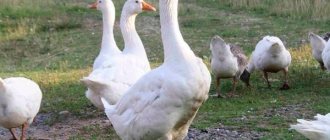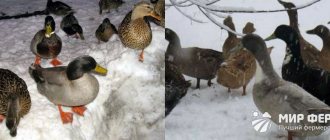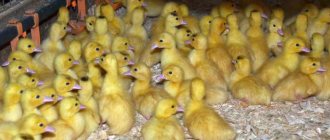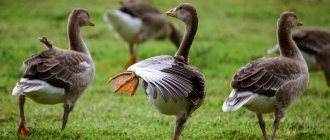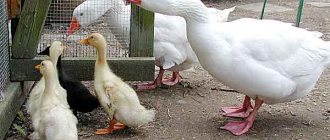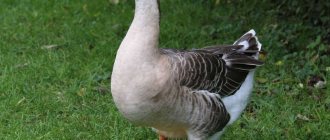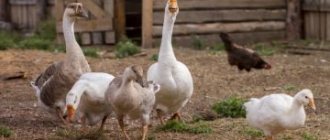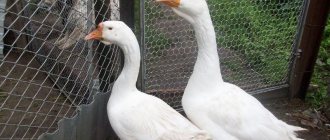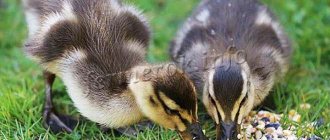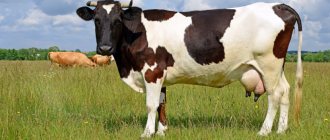1 584
no comments yet
1
Author:
Rasskazov Pavel.
Reading time: 1 minute
The ideal option is for farm birds to live separately, however, often the need to keep chickens, ducks and geese together is caused by lack of space. Ducks, due to their phlegmatic and peaceful nature, can easily get along with chickens. Geese, by their nature, are very aggressive and keeping them with chickens is problematic, but it is still possible.
Chickens + ducks + geese = fun farming
Chickens, geese and ducks are the most common types of poultry in private households. Imagine how fun and noisy it will be if they are all placed on one paddock. However, this is precisely what worries farmers - is it possible to keep poultry together and whether this is harmful to their health. In order to accurately answer this question, let's delve into the nature of these bird species.
So, geese and ducks are, first of all, waterfowl that gain weight well and develop in the presence of a pond or water source. Chickens, turkeys and ducks prefer dry conditions, and excessive dampness will only harm their health. Here comes the first argument due to the fact that keeping them together is fun, but it is very unsuitable for “land” birds, for example, chickens, turkeys and, to some extent, turkey ducks (they also do not like dampness). If geese and ducks can be kept together on the same paddock, then it is still advisable to separate the chickens or fence them off at least with a net. In addition, when walking ducks, you can also fence them off with a net in order to prevent competition: geese are still larger and more cocky.
Birds get along calmly together and do not fight if they are raised together from birth, that is, if ducklings, chickens and goslings grew up nearby. In addition, chickens, turkeys and turkeys get along well with each other on a walk. This bird can be walked together in one area.
If we talk about pasture, that is, walking on the grass, then here, we think, everyone will be comfortable, since geese and chickens will be busy picking grass, ducks will also find something to do. However, you understand that the green idyll will not last long. In just a couple of hours, if up to a dozen chickens, geese and ducks have visited the lawn, then only a pitiful hint of grass will remain.
Shared housing in a poultry house
So, if, say, everything is clear with walking and keeping them together in the yard in the summer, then a more global question arises - how to keep them together in a poultry house, is it possible to keep ducks, geese with chickens, turkeys and turkeys? Here it is worth understanding in order and considering all possible pros and cons. But more on that later. Let's say right away that it is possible to maintain, but the owner will have two or even three times more trouble and worries than with separate maintenance. And if you do keep it, you will have to organize everything so that each type of bird in the room feels comfortable.
The whole point is the hierarchy of the bird and its living conditions. The fact is that geese and ducks create dampness all the time. These birds cannot live happily without water, so they will make an individual bath even in an ordinary open drinking bowl. You understand that dampness and wet bedding cannot be avoided in this case. And this is extremely negative for chickens and turkeys, which need clean, dry bedding.
As for hierarchy, if you add geese to adult chickens or ducks, fights are possible. Geese occupy the top leading position in the bird hierarchy, so all the “lower” representatives will be driven away. You yourself understand that in such conditions neither ducks, nor chickens, nor even calmer and peaceful turkeys will have a peaceful life. This means that it is not enough to expect good growth and egg production. But, as practice shows, if goslings, ducklings and, say, chickens grew up in the same room and lived together, then quarrels are possible among such companies, but they are rare.
Advantages
Perhaps the most important advantage of keeping poultry together is saving space. This is what often forces farmers to make poultry hostels. If it is not possible for each species to build a separate room, enclosure, or divide the room into zones, then keeping them together is simply inevitable. The second (possible) advantage is cleaning one room. For many, as reviews say, it is easier to clean one large room twice a week than to clean each compartment for a different bird.
However, it’s worth thinking about here, because chickens, ducks and turkeys are cleaner birds than ducks and goslings. You will have to clean them less often, since they stain the litter less and do not create dampness. Therefore, it’s up to you to see whether it’s easier or not.
Flaws
The disadvantages of keeping all birds together are much greater than the advantages. Therefore, we will consider them in more detail.
- Unnecessary and dangerous dampness for chickens, turkeys and other “land-dwelling” birds. Wet litter not only stains the bird, but also provokes the development of various pathogenic microbes, viruses, and fungi. This increases the likelihood of illness. The solution may be increased ventilation, as well as heating in the barn. But not every owner can afford it.
- More hassle with cleaning. As poultry farmers say in their reviews, they have to clean up more often, since the birds dirty the bedding more and when they get wet, the “waste” begins to smell unpleasant.
- There is more hassle with organizing space - ducks and geese need nests at the bottom, low drinkers, and chickens and turkeys need perches, high drinkers and high nests.
- Hierarchy of birds - possible fights, since among all geese occupy the highest level, and chickens and turkeys - the lowest. This makes it difficult to keep them together and especially feed them.
- Different feeding regime and diet. You will have to fence off the bird every time to feed it, and this is quite difficult, since everyone will run to the feeders at the sight of food.
- Light regime and egg production. If you want to get more eggs from chickens, then, of course, you will need to increase the light regime. However, this can also cause even greater aggression in geese. So it turns out to be a double-edged sword.
Origin
The chicken goose is very rare in nature. It is unique and listed in the Red Book. Belongs to the duck family, order Anseriformes.
South Australia is the home of this large, beautiful goose. Researchers discovered such an amazing bird on Cape Island. The remains of flightless geese of the genus Cnemiornis were found on the island of New Zealand.
There is an assumption that these are the remains of the ancestors of the modern chicken goose. Therefore, it was first called the New Zealand-Cape Barren goose. However, this opinion was wrong. Then the mistake was corrected and they were described as a subspecies, Cereopsis novaehollandiae grisea B. They got their name from a group of islands called the Recherche archipelago.
Sharing Rules
If, nevertheless, the joint keeping of chickens, geese, and ducks is inevitable, then it is important in this case to comply with all the necessary conditions and rules. The first and most important thing is the organization of the room. If possible, divide the entire room into zones, fence off each type of bird with either nets or aviaries, giving them separate apartments. Of course, the latter option is better, since it can create individual conditions without affecting the area of another bird species. For example, you can keep chickens, turkeys and muscovy ducks in a separate enclosure; goslings and ducks will live in another “apartment”. Even if you hang a separate lamp for chickens, increasing the light level, you can use a partition to shade the area where ducks and goslings live.
The next point is the arrangement of the poultry house. Chickens and turkeys sleep in higher areas, so they need a separate roost. The same goes for nests for chickens - we do it on a hill. But geese and ducks rush to nests on the ground in a secluded shaded place, this is worth taking into account. These birds also sleep on the ground on dry bedding. But it is advisable for them to make small booths for overnight stays.
Don't forget that goslings and ducklings need baths for bathing, but chickens and turkeys need ash baths. Placing them side by side is impossible, since after two or three baths of waterfowl, the ash bath will turn into a mud bath. It is better to keep geese and ducks on permanent bedding, each time adding only the top dry layer. It is better to remove litter from chickens and turkeys more often. Another very important rule is disease prevention: carry out prevention on time, give anthelmintic drugs, disinfect the poultry house, maintain quarantine, remove sick individuals - all this will help protect the livestock from infections, the risk of which increases when kept together.
Feeding tricks
It is quite difficult to feed everyone at once when keeping chickens, ducks, goslings and other birds together. And this applies not only to different diets and feeding conditions, but also to hierarchy. Some owners practice feeding birds from one feeder, only following their hierarchy. That is, large birds feed first, geese, then ducks, and then outsiders chickens and turkeys. But you yourself understand that this is very difficult, unless the ducklings, goslings and chickens grew up together. In this case, they perceive each other as one family.
The problem of feeding and watering is that goslings and ducks splash water, and chickens scatter food. Therefore, this problem is solved with the help of special closed feeders and drinkers. A mesh partition-lattice is made over the feeders with a width between the bars of 7-10 cm, which allows the bird to stick only its head between the bars. Drinkers for chickens and turkeys are made on a hill, approximately at a height of 50-70 cm. Closed or separate drinkers will prevent water from spilling.
Well, of course, the ideal option would be to feed all birds separately in fenced off areas. This applies to goslings and other babies. Simultaneous feeding, that is, at the same time, will help minimize stress. We hope our tips will help you organize your space correctly and enjoy a fun housekeeping experience.
BONUS: Stuffed quails
Oddly enough, quail are still considered game, although for a long time all birds on sale have been raised on farms. Recipes for cooking quail can be found in many cuisines around the world, from French to Central Asian.
Lamb, beef liver, vegetables and cilantro for quail
This dish exists in Uzbekistan in many variations. They will differ in the method of preparation: boiling, stewing and steaming. The second significant difference is in the minced meat. Most often it is minced lamb, fatty or lean, with raw or sautéed onions, with or without eggs. Chopped greens can be added in large quantities... But in Bukhara, by-products are also added to the quail filling. This is exactly how we will prepare it (see recipe here )
Stuffed quails
Video “Lunch with ducks and chickens”
This video clearly shows how inconvenient it is to feed different birds in the same pen. And although they have separate feeders, the birds still climb to their neighbors to eat from them.
Having a subsidiary farm is not only interesting. It's useful and beneficial. The activity provides the table with high-quality products without harmful impurities and allows you to remember the already forgotten taste of natural food. And more and more people are raising goats, rabbits or poultry at their dachas, in their own backyards. At the same time, a common question for novice poultry farmers is about keeping different types of birds in one barn. Can chickens, ducks and geese be kept together? To understand this, it is worth considering several important aspects in detail.
Stuffed duck
Roast duck is the perfect New Year's dish. Dmitry Zotov, Brand Chef, Bureau Tsum, shared his professional knowledge with us on how to prepare a duck for baking, how to stuff it and what to serve it with
Minced meat, Brussels sprouts and mushroom sauce for duck
This duck stuffed with minced meat will be a real highlight of any holiday table. And the Perigo sauce, with which it should be served, will give the duck a bright mushroom taste and aroma.
Stuffed duck with Perigo sauce and fried vegetables
Rice, duck liver, vegetables and apples for duck
For the holiday table, many people prefer to cook chicken, unfairly ignoring such an interesting bird in terms of taste as duck. But a properly baked duck will decorate the holiday menu. Duck meat goes well with a variety of foods; rice is a classic option for stuffing this bird (see recipe here ).
Duck stuffed with rice
Oranges, vegetables, rosemary and thyme for duck
Duck with oranges is perhaps one of the most popular combinations for stuffed poultry. It is probably second only to duck with apples. But in winter, citrus fruits are especially useful, so we choose them!
Duck stuffed with oranges and herbs
Differences in poultry management
Chickens need a clean, dry, bright and warm environment. In damp, cold and insufficiently lit conditions they hatch much worse. To sleep, they need to be equipped with a perch, perches at a height of 0.8-1.2 m from the floor.
Geese are large birds. For normal maintenance there should be 1 square meter per adult. m area. Geese and ducks are waterfowl; the humidity in the goose coop is much higher than in the chicken coop. Too much light can have a negative impact on the goose population. Geese are often cocky and even fight among themselves. What can we say about small neighbors?
Advantages
There are far fewer of them than there are shortcomings. The main advantage is saving space. If it is not possible to build different barns for birds, and the area of the existing one is small, then keeping chickens, geese and ducks together is a necessity.
Some owners say that cleaning a shared poultry house is easier and faster. But when birds are crowded, cleaning must be done much more often, so this statement is controversial.
Bird habitats
Chicken geese live in small flocks. You can find them near the shore. Chicken geese do not like to swim; they rarely and reluctantly enter the water. Birds don't swim well. Even in a moment of danger they will not go into the water. They lead the lifestyle of a land bird, not an aquatic one.
During the breeding season, chicken geese are found on the banks of the river, on small islands. Food is obtained along the shore. After the nesting period, they choose meadows and lakes with fresh and brackish water. Mostly chicken geese live on small islands.
Flaws
It is worth dwelling on the shortcomings in detail, because maintenance errors can result in the loss of livestock. Note:
- It has already been said that chickens do not tolerate dampness indoors; if there is high humidity, they will definitely get sick;
- since chickens like to scatter food, and geese and ducks like to splash water, there is more dirt when keeping birds together;
- geese offend small neighbors, this can affect the egg production of chickens and ducks;
- Chickens need a lot of light to lay eggs well; in geese, too much light and crowding can cause diseases.
- for hatching chicks, a calm environment is required, which is impossible when living together;
- Each species needs to create comfortable nests; this is difficult with general maintenance.
The need for separate keeping of different species of birds is stipulated in the Law of the Russian Federation of May 14, 1993 No. 4979-1 “On Veterinary Medicine” (Article 18 and its subsequent amendments and additions).
Rules for keeping poultry
There are three types of domestic chickens. Egg, meat-egg and meat. Households often keep egg-bearing breeds, since they can produce a large number of eggs, rich broth, and tasty meat. One laying hen produces up to 200 eggs per year.
Chickens are kept in a warm, dry barn; in winter, additional lighting and heating should be provided. Daylight hours for laying hens are 14 hours. When the temperature in the chicken coop is below +15°C, chickens begin to lay eggs much worse. The optimal temperature is +23-25°C. From time to time, chickens are treated with flea repellents and containers with ash are placed, as they love ash baths. Perches must be provided for sleeping. The chicken coop is equipped with a manhole that leads to a walking area for the birds to move independently.
Large and capricious representatives of the bird family. A dry, clean goose barn with bedding and drinkers placed on pallets is the best home for geese. They sleep on the floor. It was said above that each individual needs 1 sq. m area. They don’t miss the opportunity to splash around, so the humidity in the goose coop is higher than in rooms with chickens or turkeys.
Keeping ducks is not much different from keeping geese. 1 sq. m is enough for 2-3 individuals. The feeding and drinking conditions of ducks are similar to those of geese. It is quite possible to keep ducks and geese in the same coop.
An important condition for any poultry house is heat preservation, so you should not make a barn higher than 2 meters. Remember about ventilation.
Feeding
Waterfowl species
Feeding varies between waterfowl and other poultry. In summer, geese spend most of their time walking, feeding on grass (dandelions, nettles, clover), and happily eating vegetables.
Remember: unlike ducks and chickens, geese should not be given dairy products other than cottage cheese. They are poorly tolerated by birds.
The abundance of green food in summer allows you to significantly save on food. During the warm season, birds can be released into one enclosure. With an abundance of food, they get along well and walk peacefully.
Chalk, fish and bone meal must be added to food. Mixed feed, oats, corn, peas, and millet are used as dry food.
Birds must have clean water in their drinking bowls. Wet mash should be made crumbly and should not be allowed to sour.
In winter, hay or pre-prepared silage is added to the feed. One winter feeding must be wet. The presence of grated carrots in food will enrich your pet's diet with vitamins. In addition, we should not forget about chalk, shells and small pebbles, which are necessary for birds. A balanced diet will allow your pets to grow and develop well.
Chicken nutrition
In the summer, when chickens roam freely, they find bugs, worms and other protein foods; they gradually consume grass, enriching the body with vitamins; they love fresh vegetables from the garden, so it is necessary to ensure that the birds do not leave the enclosure. The share of feed in their food in the summer decreases significantly. To feed chickens, oats, millet, sunflowers, raw and boiled vegetables are used. Potatoes should only be given boiled.
In winter, mineral and vitamin supplements, fish oil, bone and fish meal, boiled or raw vegetables are required in the diet. Vegetables must be washed to avoid an outbreak of intestinal infections. You should not feed your pets rotten or moldy foods, green potatoes or tubers with sprouts. The food must be of high quality.
If there is no severe frost, the feathered brethren must be allowed out for a walk. 1-1.5 hours of daily walks will improve the well-being of birds and strengthen the immune system.
All pets need to change their water daily. Drinkers are washed with a 2% soda ash solution and rinsed well.
Little tricks
Some tips for novice poultry farmers.
- Feeders with dry food are placed around the perimeter of the barn.
- They are made so that birds cannot climb inside, scatter food or pollute with feces.
- Feeders for chickens and ducks are placed on the floor, and for geese - at a height of 20 cm from the level of the litter.
- Pallets are needed to avoid dampness in the barn.
- There should be enough feeders so that birds do not create crowds near them.
- Metal and plastic feeders and drinkers are easier and more convenient to clean.
- When kept together, the ducks are fed first, since they are more gluttonous and will not allow the others to eat properly.
Stuffed chicken and chickens
How to cook chicken ? What a tricky question, because everyone has their own favorite way to cook this popular bird. For the holiday, you definitely need to stuff the chicken !
Grapes, porcini mushrooms and spices for a whole chicken
Chicken stuffed with grapes and porcini mushrooms will decorate any holiday table. The process of preparing it is not the easiest, but such a dish is not prepared every day.
Chicken stuffed with grapes and porcini mushrooms
Cottage cheese, prunes and cashews for chicken
Easy to prepare stuffed chicken with tender minced cottage cheese, nuts and prunes . This dish can be classified as a healthy holiday dish.
Chicken stuffed with cottage cheese and nuts
Champignons, prunes and paprika for chicken
Chicken stuffed with mushrooms is a real holiday dish. Chicken bakes faster than goose or duck, so it won’t take you much time to cook. We chose champignons for the filling, but you can replace them with porcini mushrooms.
Chicken stuffed with mushrooms
Quince for chicken
For this stuffed chicken you need, of course, the chicken itself and... quince. And that's it, not counting the salt and pepper. Everything is extremely minimalistic and very nice. Fragrant quince gives a special taste to the chicken and itself will turn out very tasty. See the recipe here .
Chicken stuffed with quince
Rice, dried fruit and thyme for chicken
Stuffed chicken is always festive, unusual and delicious. Such a chicken can rightfully become the queen of the festive table! It is very appetizing and impressive, and all thanks to the orange-honey glaze. See the recipe here .
Chicken stuffed with rice and dried fruits, baked in orange-honey glaze
Raising chicks
Most poultry farmers note that if chickens, ducklings and goslings grew up together, then normal relationships are established between them, and it is easier to keep them in the same house.
The diet of all chicks in the first days of life is no different, this greatly simplifies keeping them together.
All chicks must live separately from adults.
They should be fed at the same time so that the babies do not experience stress. It is necessary to carefully monitor the health of the chicks.
Summary
At the beginning of a farming career, when a person is just determining the size of the bird population, species, and comprehends other subtleties of poultry farming, and there are few birds, joint keeping is possible. Over time, experience and pets become more numerous, and each owner does what is convenient for him. The main thing to remember is that quality care and care is the key to the excellent condition of the livestock. This will allow you to get high-quality products for the table and significant profits for the family budget.
I store hay in the attic of the chicken coop barn (the barn itself measures 3x3 meters). The barn (it is made of logs) is caulked inside and out and covered with boards. The window faces south; the barn is always warm and full of light.
I keep both chickens and geese in the barn together, they live peacefully. for chicken nests and for bedding for geese, where they lay eggs, and cover the floor with sawdust . In winter, I don’t remove the poultry’s bedding; I just sprinkle fresh straw or hay on top of the dirty bedding. Manure and straw rot and give off heat, which is why my chickens don’t freeze. I get up every day at six in the morning so that I can feed all my animals before school. In winter, in the mornings I also turn on the lights for the chickens and geese in the barn. My geese spend the night on the floor in straw, and in winter I fence off a corner of the barn for them and put straw in them so that they lay eggs there.
Last year I had a whole flock of geese - twelve heads. We bought them at the market on a daily basis, raised them at home in a TV box in which we hung a lamp, and fed them day and night. In mid-April, when the goslings had grown up, we placed a large iron cage in the yard and let them in for their first grass. The goslings are both warm and safe in the cage. Later we started letting them out for walks.
All last summer I herded the geese in the morning and evening for two hours, and the rest of the time they spent with the chickens in the pen: they grazed the grass that I brought from the garden. This summer I sometimes released geese onto the meadow next to the garden. I didn’t let the chickens out there because they immediately ran into the garden to peck vegetables. And geese are smart and obedient birds; if they know that they can’t go into the garden, they don’t go. We built a large pen especially for chickens , we throw grass in there, and the chickens eat it with pleasure.
Our house is located far from the pond, so my geese don’t go swimming in it. trough for them , in which they swim with pleasure; I change the water in it every other day. Our water supply is located next to the chicken coop, so there are no problems with water. I pour plenty of it for the bird. In hot weather I water the geese with cold water from a hose , they really like it. There are also large holes near the house; in heavy rain they fill with water, and geese swim there. By the way, my geese really like to take a “shower” - they stand in the rain, spreading their wings, not like chickens hiding in the barn. Geese guard the house better than a dog: when someone else passes by, they cackle, but the dog begins to bark after them.
In May - early June I harvest nettles for the birds - at this time they are juicy, very healthy and nutritious. My grandmother and I start mowing hay from the end of June to the end of August; our farm requires a lot of it.
I sell chicken eggs, but we eat goose eggs ourselves. I use the proceeds to buy feed and grain. I feed the bird three times a day in the summer, and twice a day in the winter. I thickly mix the bran with mixed feed, potato peelings, and bread in water. In addition, I separately pour a small pan of grain into the bird once a day. I save grain because it is very expensive and it is difficult to get it here. Of course, I give the bird a shell, nettles, meadow clover, other grass in the summer, and a little hay in the winter. Geese and chickens eat it all with pleasure.
By the way, in addition to chickens and geese, I keep rabbits , I made a separate small nook for them, and put a cage there. I have only two rabbits, or rather female rabbits: Mom is white, and Daughter is black. I don’t buy a male for them, because there is not enough space in the barn and there will be nowhere to place their offspring, and my parents are still against expanding the farm. I feed the rabbits in the morning and evening. I give them water, barley, dried bread, grass in summer, and dry nettles or hay in winter.
- Author: Maria Sukhorukikh
Rate this article:
- 5
- 4
- 3
- 2
- 1
(0 votes, average: 0 out of 5)
Share with your friends!
Breeding conditions
For the most part, the chicken goose prefers land and walking rather than flying or swimming. A negative attitude towards bodies of water does not prevent birds from raising their chicks near the water. When this crucial moment comes, the geese retire as a pair. The rest of the time they live with everyone else in the flock. They feed on lush grass where they graze.
Before mating occurs, the male performs a beautiful mating dance. The nest is made directly on the grass or in open areas, or in rocks. The inside of the nest is lined with soft down and feathers. The female lays 4-5 eggs. The eggshell is smooth and whitish-yellowish in color. Married couples are formed once and for life. But if for some reason a misfortune occurs and one of the spouses dies, then the remaining spouse again forms a family with a single bird.
The incubation period for eggs lasts approximately 5 weeks. From the moment of birth, chicks are always near their mother. During this period, dad diligently protects his family. Shows excessive aggressiveness towards others.
